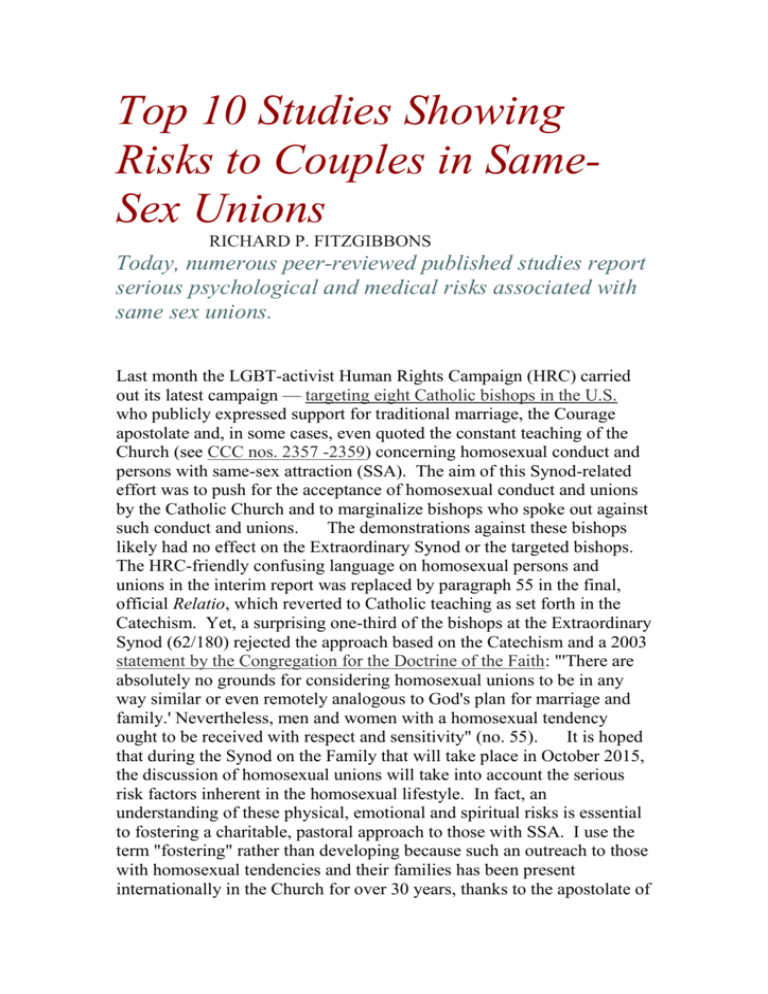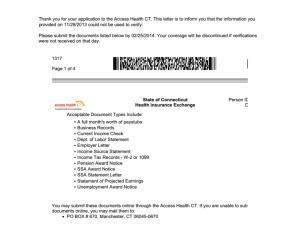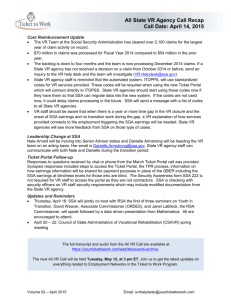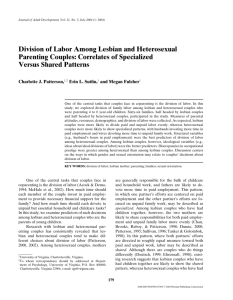
Top 10 Studies Showing
Risks to Couples in SameSex Unions
RICHARD P. FITZGIBBONS
Today, numerous peer-reviewed published studies report
serious psychological and medical risks associated with
same sex unions.
Last month the LGBT-activist Human Rights Campaign (HRC) carried
out its latest campaign — targeting eight Catholic bishops in the U.S.
who publicly expressed support for traditional marriage, the Courage
apostolate and, in some cases, even quoted the constant teaching of the
Church (see CCC nos. 2357 -2359) concerning homosexual conduct and
persons with same-sex attraction (SSA). The aim of this Synod-related
effort was to push for the acceptance of homosexual conduct and unions
by the Catholic Church and to marginalize bishops who spoke out against
such conduct and unions.
The demonstrations against these bishops
likely had no effect on the Extraordinary Synod or the targeted bishops.
The HRC-friendly confusing language on homosexual persons and
unions in the interim report was replaced by paragraph 55 in the final,
official Relatio, which reverted to Catholic teaching as set forth in the
Catechism. Yet, a surprising one-third of the bishops at the Extraordinary
Synod (62/180) rejected the approach based on the Catechism and a 2003
statement by the Congregation for the Doctrine of the Faith: "'There are
absolutely no grounds for considering homosexual unions to be in any
way similar or even remotely analogous to God's plan for marriage and
family.' Nevertheless, men and women with a homosexual tendency
ought to be received with respect and sensitivity" (no. 55).
It is hoped
that during the Synod on the Family that will take place in October 2015,
the discussion of homosexual unions will take into account the serious
risk factors inherent in the homosexual lifestyle. In fact, an
understanding of these physical, emotional and spiritual risks is essential
to fostering a charitable, pastoral approach to those with SSA. I use the
term "fostering" rather than developing because such an outreach to those
with homosexual tendencies and their families has been present
internationally in the Church for over 30 years, thanks to the apostolate of
Courage International (www.couragerc.net).
Today, numerous peerreviewed published studies report serious psychological and medical risks
associated with same sex unions. Ten of these studies are described
below.
1. One of the most extensive studies of same-sex couples found that only
seven of the 156 couples had a completely exclusive sexual
relationship and that the majority of relationships lasted less than
five years. Couples whose relationship lasted longer than five
years incorporated some provision for outside sexual activity in
their relationship. The psychologists wrote, "The single most
important factor that keeps couples together past the 10-year mark
is the lack of possessiveness. ... Many couples learn very early in
their relationship that ownership of each other sexually can be the
greatest internal threat to their staying together" (McWhirter, D.
and Mattison, A. 1985. The Male Couple: How Relationships
Develop. (Upper Saddle River, NJ: Prentice Hall). The risks?
Outside sexual activity can expose the partner to sexuallytransmitted diseases, and relationship break-up typically gives rise
to emotional distress. 2. Partner instability is also present in lesbian relationships. A
2010 study in a respected peer-reviewed journal, showed lesbian
relationships to be statistically less stable than heterosexual
relationships. (Schumm, W. 2010. "Comparative Relationship
Stability of Lesbian Mother and Heterosexual Mother Families: A
Review of Evidence," Marriage and Family Review 46: 499509).
3. A 2011 study analyzed the impact of sexual orientation on suicide
mortality in Denmark during the first 12 years after legalization of
same-sex registered domestic partnerships (RDPs), using data from
death certificates issued between 1990-2001 and Danish census
population estimates. This study found that the age-adjusted
suicide risk for same-sex RDP men was nearly eight times greater
than the suicide risk for men in a heterosexual marriage. (Mathy,
R. et al. 2011. "The Association between Relationship Markers of
Sexual Orientation and Suicide: Denmark, 1990-2001," Social
Psychiatry and Psychiatric Epidemiology, 46: 111-117.
4. In a 2010 report, the U.S. National Longitudinal Lesbian Family Study,
40 percent of the lesbian couples who had conceived a child by
artificial insemination had broken up. (Gartrell, N. & Bos, H.
2010. "U.S. National Longitudinal Lesbian Family Study:
Psychological Adjustment of 17-year-old Adolescents," Pediatrics,
126 (1): 28-36.) 5. A 2002 study of lifetime abuse victimization revealed that 7 percent of
heterosexual males reported being abused whereas 39 percent of
males with SSA reported being abused by other males with SSA.
(Greenwood, G. et al. 2002. "Battering victimization among a
probability-based sample of men who have sex with men,"
American Journal of Public Health, 92:1964–69). 6. A major study published in the journal "Cancer" in May 2011 revealed
that men with SSA in California are twice as likely to report a
cancer as heterosexual men. Most troubling is the mean age of
onset of cancer in the men with SSA — age 41, compared to age
51 in heterosexual males. (Boehmer, U. et al. 2011, "Cancer
Survivorship and Sexual Orientation," Cancer, 117:3796–
3804.
SSA respondents who had become more chaste
had an improvement in their overall mental health.
Measures of authentic spirituality were also positively
correlated to increased mental health.
7. A November 12, 2014 article in the Wall St. Journal on HPV-related
throat cancers stated that it increased by 72 percent between 2000
and 2004. Most of that growth has been in men and the number of
sexual partners was suggested as a contributing factor. A
researcher stated that, "the problem with HPV-positive oral cancer
is that premalignant lesions are not clinically detectable. They're
deep within the tonsils that are in the base of the tongue. By the
time HPV-infection is detected, they usually already have Stage 3
or 4 cancer."
8. Finneran and Stephenson (2012) conducted a systematic review of 28
studies examining interpersonal violence among men who have sex
with men. The authors concluded that, "The emergent evidence
reviewed here demonstrates that IPV — psychological, physical,
and sexual — occurs in male-male partnerships at alarming rates"
(p. 180). (Finneran, C., Stephenson, R. 2012. "Intimate Partner
Violence Among Men Who Have Sex With Men: A Systematic
Review," Trauma, Violence and Abuse, 14: 168-185.) A 2007
study published by the New York Academy of Medicine found that
over 32 percent of active homosexuals report that they have
suffered "abuse" by one or more "partners" during the course of
their lives. Fifty-four percent (n = 144) of men reporting any
history of abuse reported more than one form. Depression and
substance abuse were among the strongest correlates of intimate
partner abuse. (Houston, E. & McKiman, D.J. 2007, "Intimate
Partner Abuse Among Gay and Bisexual Men: Risk Correlates and
Health Outcomes," Journal of Urban Health 84: 681-690.)
9. A 2014 systematic review of 19 studies examining associations
between intimate partner violence (IPV) and men with SSA. The
pooled lifetime prevalence rate of any form of IPV was 48
percent. (Buller, A. et al. 2014. "Associations between Intimate
Partner Violence and Health among Men Who Have Sex with
Men: A Systematic Review and Meta-Analysis." PLOS Medicine,
11(3): e1001609. doi:10.1371/journal.pmed.1001609.)
10.
Research on men with SSA in Amsterdam found that 86 percent of
new HIV infections occur within steady partnerships. The
researchers concluded, "Prevention measures should address risky
behavior, especially with steady partners, and the promotion of
HIV testing." (Xiridou, M. et al., 2003. "The contribution of
steady and casual partnerships to the incidence of HIV infection
among homosexual men in Amsterdam," AIDS 17:1029-38.)
Research on persons who had sought help from Courage revealed that
those with SSA had more mental health distress than a heterosexuallyoriented, normative sample. SSA respondents who had become more
chaste had an improvement in their overall mental health. Measures of
authentic spirituality were also positively correlated to increased mental
health. Positive correlations were also found between chastity, religious
participation and self-reported measures of happiness. (Harris, S. 2009.
"Mental health, chastity and religious participation in a population of
same-sex attracted men." Doctoral dissertation.)
The recommendation
of an international expansion of this effective apostolate should be
considered by the Synod as a primary pastoral outreach to those with
homosexual tendencies and their families. As St. John Paul II said of this
apostolate, "COURAGE is doing the work of God!"
Acknowledgement
Richard P. Fitzgibbons. "Top 10 Studies Showing Risks to Couples in
Same-Sex Unions." Aleteia (December, 2014).
Reprinted with permission of aleteia. See the original article here.
The Christian universe is immense, with thousands and thousands of
websites, blogs and information. Through partnership with content
suppliers, Aleteia is a unique platform for those seeking the truth.
The Author
Rick Fitzgibbons is the director of the Institute for Marital Healing
outside Philadelphia. He has coauthored Helping Clients Forgive: An
Empirical Guide: An Empirical Guide for Resolving Anger and Restoring
Hope with Dr. Robert D. Enright. The second edition of this book is in
press. APA Books also offers a DVD on forgiveness by him and Dr.
Enright. Dr. Fitzgibbons is an adjunct professor at the Pontifical John
Paul II Institute for Studies on Marriage and Family at Catholic
University and is board member of the International Institute for
Forgiveness, www.forgiveness-institute.org. He is a consultant to the
Congregation for Clergy at the Vatican. His website is
maritalhealing.com.
Copyright © 2014 Aleteia










